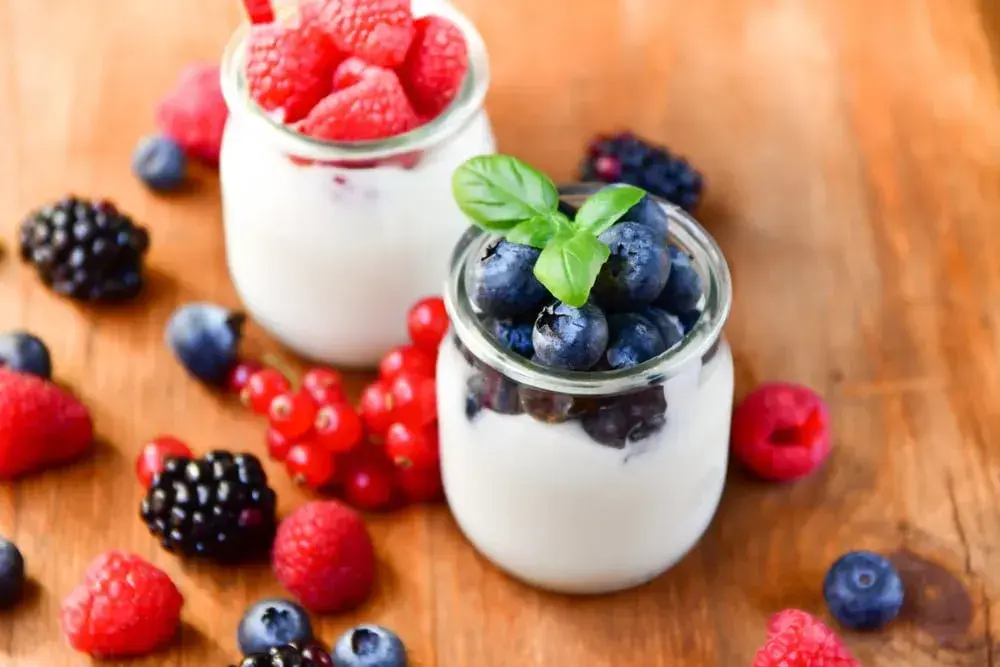
/assets/images/provider/photos/2579754.jpg)
Sugar: it’s the food everyone knows is bad for them, yet seems impossible to give up. If you have a sweet tooth, don’t blame yourself. Humans have been designed to crave sweets because in ancient times, foods with sugar were hard to come by.
Today, however, the pendulum has swung in the opposite direction: it’s downright difficult to avoid sugar because it’s in so many foods. And as a result, even people who are avoiding desserts and “sweet treats” could still be unknowingly loading up on added sugar that’s hidden in many seemingly healthy foods.
You can eat less sugar and get healthier — but it will take some extra effort and planning to do it. Here are some tips that can give you the tools and motivation you need to make this change for the better in your life.
1. Begin with a realistic goal
Many people find that quitting sugar cold turkey is too difficult, especially if they are used to eating sweetened, processed foods and drinks each day. And trying to achieve a lofty goal such as “zero sugar starting today” could set you up for failure and frustration early in the process.
Rather than go for an all-or-nothing approach, try a more realistic — and doable — decrease in sugar. Focus on replacing unhealthy sweets with fruits and vegetables. Allow yourself a treat for special occasions, such as a piece of cake at a wedding, but keep portions small.
Seeing sugar as something you will limit — not eliminate — can make it easier to stick to your healthier plan in the long run.
2. Cut out the soda
If you drink soda or fruit juice regularly, making this one change is the biggest way to dramatically decrease the amount of sugar you consume each day. Yes, it may be drastic to suggest you give something up completely, but this is one case where a cold turkey approach is best. Just one serving of soda can send you over your daily sugar intake, so making this change can be a powerful step forward to better health.
Consuming sugary beverages like soda is the biggest cause of excess sugar in the American diet. When you drink soda, it floods the body with fructose that the liver must process. This releases excess cholesterol and triglycerides into your blood. As a result, you may have an increased risk of heart attack and stroke.
In addition, sodas and processed juices contain plenty of calories that will add pounds without giving you any feeling of satiety.
So, soda harms your heart health and loads the body with sugar and calories but provides no feeling of fullness or satisfaction afterward. In fact, the high sugar content of soda may even make you hungrier than you would have been without drinking the soda. Drinking soda is also linked with other unhealthy behaviors, such as lack of exercise and eating fast food.
Fortunately, there are a number of healthier, satisfying alternatives. Plain carbonated water with a squeeze of fresh lemon and a pinch of stevia may satisfy a soda craving. Or, try it with fresh herbs like mint. Matcha or green tea delivers powerful antioxidants and some extra pep without the sugar and unhealthy additives of soda.
If plain water isn’t appealing, be creative with alternatives like unsweetened tea and kombucha to find your new beverage of choice. And give it some time: After giving up soda, many people report that they no longer crave it and that it tastes far too sweet and syrupy to even be enjoyable.
3. Stay hydrated
Now that you’re consuming a soda alternative without added sugar, make sure you drink plenty of it — especially water — throughout your day. When the body is well hydrated, you’ll have more energy and the ability to fight off an afternoon slump. This extra pep could even help you with your exercise goals! Don’t forget to bring your favorite water bottle along for some extra fluids while you work out.
Staying well hydrated may also help with your eating habits. Many people confuse the feelings of hunger and thirst, prompting them to reach for a snack when they just need to hydrate. This could be one of the reasons why being dehydrated is associated with a higher BMI.
4. Make grocery shopping a priority
One of the reasons people reach for the ready-made, high-sugar processed foods is that they’re hungry and they want something to eat now. After all, it’s easy to give in to the vending machine when your stomach is grumbling and you have no other options.
You can overcome this temptation by going grocery shopping regularly and keeping healthy foods on hand at home and work. But who has the time to get to the store? You do — if you make it an important meeting on your schedule. Put grocery shopping on your calendar and treat it like any other event. After all, what’s more important than your health and well-being?
Make grocery shopping a priority in your life so it gets done, and you’ll likely find it much easier to avoid those high-sugar foods that aren’t doing your health any favors.
5. Get the right amount of protein
You don’t need to follow a high-protein diet to meet your body’s needs — in fact, consuming excessive amounts of animal protein for long periods may be bad for your health. On the flip side, not getting enough protein from healthy sources could leave you feeling hungry because protein has been shown to increase satiety. Ultimately, eating too little protein could make it harder to say “no” to that candy bar or donut.
Focus on plant-based proteins that pair well with healthy sources of carbohydrates. Although fruit contains plenty of nutrients, for instance, it also contains sugar and carbs. But eating fresh fruit with a handful of nuts or seeds will add some satisfying, plant-based protein to help you feel full. Legumes like chickpeas or lentils are another great source of plant protein. Even many vegetables contain protein and very little sugar — another reason to eat more veggies. If you include these types of foods with every meal or snack, you’ll be less inclined to reach for sugary foods.
6. Become a food label reader
Eliminating all processed foods isn’t necessary if you’re trying to eat less sugar. In fact, some packaged foods like popcorn, yogurt, and nut butters can be great additions to a healthy diet. You simply need to know which processed foods don’t contain added sugar.
But, in order to find this out, you’ll have to be a bit of a detective. There are many different names for sugar, and you’ll need to read the ingredients list to see if your favorite food contains one of them.
Just assuming that a food is safe because it doesn’t taste sweet or has a healthy-sounding name is not a reliable way to shop. This is because even savory foods like ketchup, salad dressing, or marinara sauce often contain sugar or high-fructose corn syrup. So, learn how to identify sugar in the ingredients and choose your packaged, processed foods wisely.
7. Skip the “fat-free” foods
Choosing fat-free over a full-fat product may be tempting when you’re trying to lose pounds, but this is not necessarily a healthier option. Many low-fat or fat-free foods contain added sugar to enhance their taste, while a full-fat version may be more satisfying with fewer calories and no sugar.
A cup of unsweetened, full-fat Greek yogurt, for example, contains 6 grams of natural sugars from the lactose in milk, with no added sugar. But, a fat-free cup of vanilla yogurt could contain more than double this amount, much of it in the form of added sugar.
What’s more, healthy fats can add flavor and richness to foods without sugar. Your own vinegar and olive oil mixture on a salad can be tastier — and far more nutritious — than a sugar-laden but fat-free dressing.
8. Start your day without sugar
What you eat first can help set the tone for your whole day. Unfortunately, many breakfast foods are high in sugar, which can set you up for sugar cravings before you even get to lunch. In fact, eating sugar may even be addictive — so start your day off right with a breakfast that doesn’t include sucrose or fructose.
Skip sugary cereals, granola, or pastries for breakfast and instead opt for a protein boost with natural, whole foods. An egg with avocado will fill you with fiber, protein, and heart-healthy fats. Or, have some plain Greek yogurt with some almonds and berries. Try adding a little bit of stevia if you need a little sweetener.
9. Consider an app to help you along
When you’re adjusting to a new way of eating without added sugar, you may find it difficult to keep track of how much sugar you’ve eaten. But using an app that will help you look up foods and keep track of sugar, calories, or other metrics can be helpful and even enjoyable to use.
An app is an easy way to track your progress and celebrate the success you have in working toward a healthier diet. It also takes the guesswork out of adding up the different foods and drinks you consume each day.
Many health apps, like MyFitnessPal, are free and allow you to set goals for your sugar intake, calories, exercise, and other metrics.
10. Commit to getting more sleep
Few things are as important to your health as quality, adequate sleep each night. Lack of quality sleep could be standing in the way of your weight-loss goals and could even put you at risk of serious, chronic diseases like diabetes, heart disease, and cancer.
Many people treat sleep like an optional activity that they can neglect day after day. They tell themselves they’re too busy to get seven or eight hours. Unfortunately, this mindset is what’s preventing many people from being a healthier, happier version of themselves.
If you’re not getting at least seven hours of sleep regularly, it’s time to focus on this crucial step toward better health. Find ways to get to bed earlier and reset your sleep habits. Even just 15 to 30 extra minutes of sleep instead of browsing social media in the evening is beneficial. You may be amazed at how much better you feel — both physically and mentally — in just a few days when you give your body the gift of restorative sleep.
11. Focus on your overall well-being — and not on sugar
Fixating on one single, difficult goal — like eating no sugar at all — can actually make you want to eat sugar more. And, if you slip up and have a treat, you may feel discouraged.
Rather than thinking of sugar as the enemy or trying to follow a strict no-sugar plan, think each day about ways you can nourish your body and take steps to be healthier. Think of the foods you eat as fuel to help you be at your best. Focus on the delicious, healthy foods you can have, rather than what you can’t. Be proud of each step you take in the right direction every day, and forgive yourself for slip-ups.
Cutting back on sugar isn’t easy, but the rewards are tremendous. You may find that the less sugar you eat, the less you crave it — and that it motivates you to make other healthy changes too.
Achieving a healthier life can happen for you if you start to make small changes today. We’re here to help you on that journey. Garcia Weight Loss offers personalized weight-loss programs designed to work for you and your body’s unique needs. Contact us today for your no-cost consultation!



